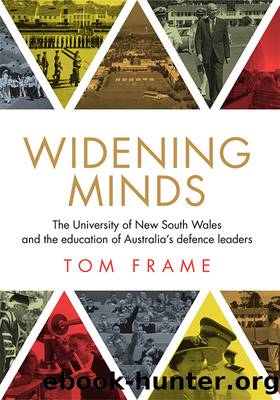Widening Minds by Frame Tom;

Author:Frame, Tom;
Language: eng
Format: epub
Publisher: University of New South Wales Press
Published: 2017-11-06T00:00:00+00:00
A compromise was sought which would cover up this dichotomy since there was a desire to create a sense of unity at this stage. The phrase âwithin the ambitâ was accepted because it has a geographical connotation (âwithin the perimeter of â) which both sides could accept, while stopping short of stating that the University College was part of the Academy.13
The Agreement reflected and deflected the tensions and the ambiguities that had not been resolved by mid-1981. The ADF wanted to avoid the appearance that it had no control over junior officer education, while UNSW wanted to avert any criticism that Defence was controlling the curriculum. There was, however, trust on both sides and an acceptance that a complex, if slightly contradictory, agreement was the best they could achieve within the available time. Despite previous reservations about the benefits of a tri-Service Academy in some sections of the ADF and the Defence Department, once the 1981 Agreement was signed there was complete commitment on all sides to seeing it built efficiently and on time. The Defence interface would initially be led by Colonel Alan Hodges of the Defence Force Policy Division (representing the ADF) and Rob Tonkin, the CEO of the Defence Training Branch (representing the Defence Department). Defence was pleased to be working with UNSW and did not anticipate any major difficulties during the building phase. The University was highly respected within Defence and well regarded within the higher education community.
The principal challenge, according to Tonkin, was for Defence to be clear about what it wanted and needed from the University.14 While there was agreement that the undergraduate student body would not include civilians, on the grounds that they would dilute the military culture, there was no vision for postgraduate education and no articulated strategy for exploiting academic research. Defence accepted that postgraduates were needed to promote a research culture. There had been postgraduates at Duntroon, albeit in limited numbers. The postgraduates could use the new facilities beyond 4 p.m., when most cadets were engaged in recreational sport and military training. Defence was yet to appreciate that it would benefit directly from the presence of postgraduates and their supervisors at the Academy in terms of research outputs. In the years that followed and particularly in relation to Masters courses, military students mixed with mid-level public servants and formed relationships across government departments and agencies that would prove invaluable when goodwill and collaboration were needed for a whole-of-government initiative.
Defence certainly wanted to see an increase in cadet retention levels, as the combined resignation and failure rate was then approaching 20 per cent. Tonkin saw the evolving relationship between the two institutions as a diarchy, with the Rector and Commandant reporting to a Council that would ensure the Academy pursued a consistent purpose. The Council had no executive authority over the Academy or the College. It was to serve as a forum to express concerns and exert influence. Behind the scenes, the Chief of Defence Force Staff (renamed Chief of the
Download
This site does not store any files on its server. We only index and link to content provided by other sites. Please contact the content providers to delete copyright contents if any and email us, we'll remove relevant links or contents immediately.
| Administration | Adult & Continuing Education |
| Business School Guides | College Guides |
| Financial Aid | Graduate School Guides |
| Law School Guides | Medical School Guides |
| Test Preparation | Vocational |
Spare by Prince Harry The Duke of Sussex(5132)
Navigation and Map Reading by K Andrew(5131)
Tuesdays with Morrie by Mitch Albom(4727)
Machine Learning at Scale with H2O by Gregory Keys | David Whiting(4257)
Cracking the GRE Premium Edition with 6 Practice Tests, 2015 (Graduate School Test Preparation) by Princeton Review(4247)
Never by Ken Follett(3875)
Goodbye Paradise(3760)
What It Really Takes to Get Into Ivy League and Other Highly Selective Colleges by Hughes Chuck(3715)
Harry Potter and the Prisoner of Azkaban (Book 3) by J. K. Rowling(3322)
Fairy Tale by Stephen King(3305)
Pledged by Alexandra Robbins(3152)
Kick Ass in College: Highest Rated "How to Study in College" Book | 77 Ninja Study Skills Tips and Career Strategies | Motivational for College Students: A Guerrilla Guide to College Success by Fox Gunnar(3095)
A Dictionary of Sociology by Unknown(3044)
Sapiens and Homo Deus by Yuval Noah Harari(3025)
Reminders of Him: A Novel by Colleen Hoover(3010)
The Social Psychology of Inequality by Unknown(2987)
Graduate Admissions Essays, Fourth Edition: Write Your Way into the Graduate School of Your Choice (Graduate Admissions Essays: Write Your Way Into the) by Asher Donald(2890)
Will by Will Smith(2872)
Zero to Make by David Lang(2753)
